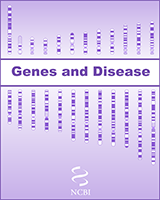NCBI Bookshelf. A service of the National Library of Medicine, National Institutes of Health.
National Center for Biotechnology Information (US). Genes and Disease [Internet]. Bethesda (MD): National Center for Biotechnology Information (US); 1998-.

Refsum disease is a rare disorder of lipid metabolism that is inherited as a recessive trait. Symptoms may include a degenerative nerve disease (peripheral neuropathy), failure of muscle coordination (ataxia), retinitis pigmentosa (a progressive vision disorder), and bone and skin changes. Refsum disease is characterized by an accumulation of phytanic acid in the plasma and tissues. is a derivative of phytol, a component of chlorophyll.
In 1997 the gene for Refsum disease was identified and mapped to chromosome 10. The protein product of the gene, PAHX, is an enzyme that is required for the metabolism of phytanic acid. Refsum disease patients have impaired PAHX - phytanic acid hydrolase. It is thought that Refsum disease is a peroxisomal disorder, since human PAHX contains PTS2 localization sequences, which target it to the peroxisome.
Our bodies can not synthesize phytanic acid: we have to obtain all of it from our food. Therefore, prolonged treatment with a diet deficient in phytanic acid can be beneficial.
- Genome view see gene locations
- Entrez Gene collection of gene-related information
- BLink related sequences in different organisms
- Research articles online full text
- Books online books section
- OMIM catalog of human genes and disorders
- Refsum disease - Genes and DiseaseRefsum disease - Genes and Disease
Your browsing activity is empty.
Activity recording is turned off.
See more...
